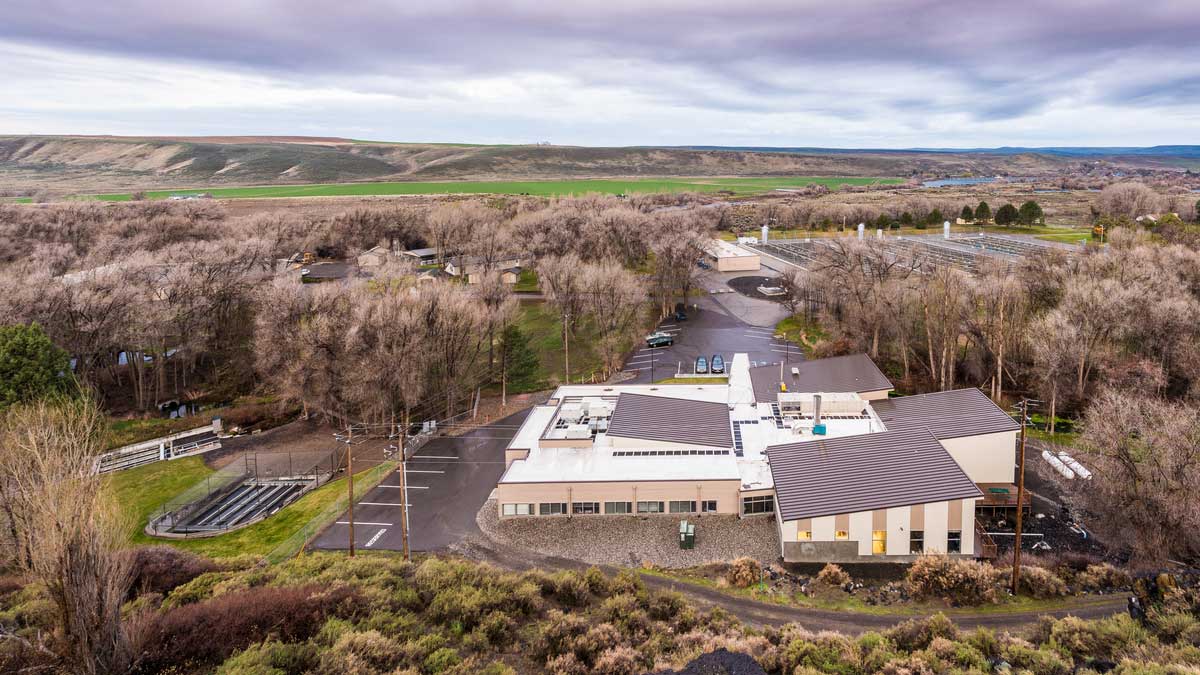Facilities
The University of Idaho Aquaculture Research Institute has research facilities for conducting fish rearing studies both on the Moscow campus and in Hagerman. Fish rearing facilities are both indoor and, in Hagerman, outdoor. Indoor facilities are biosecure with environmental controls.
Laboratory managers oversee the fish rearing laboratories at each location and provide the continuity necessary for fish care, feeding and all operations needed for successful research studies by faculty, students and other partners.

The Aquaculture Research Institute (ARI) has research facilities both on the Moscow campus and in Hagerman, Idaho.
On the University of Idaho campus, the ARI operates two wet laboratories that have controlled photoperiods and are supplied with either well or dechlorinated municipal water. A laboratory manager overseas the wet labs and provides the continuity necessary in fish care, feeding and operations for successful studies.
The Moscow campus wet lab facilities are available to researchers across U of I and Washington State University campuses for a nominal fee.
Cold Water Laboratory
The Cold Water Laboratory operates on the Moscow campus as a water limited recirculating facility. There are currently seven independent recirculating systems on backup power that can accommodate a variety of cold-water species, including salmonid species and sturgeon. The facility also maintains one warmwater system for rearing tilapia. Each system has independent chilling/heating, biofiltration and UV treatment. The largest system has four four-meter diameter tanks for rearing of large populations or broodstock. The other systems are high replicate systems, comprised of as many as 66 tanks. The Cold Water Lab has the capability to incubate eggs in Heath tray incubators and McDonald jars. Fry can also be held in fiberglass troughs and fed with either single pass or recirculating water. Temperatures in the systems can be maintained between 4 degrees Celsius and 20 degrees Celsius.
Aquatic Animal Research Facility
The Aquatic Animal Research Facility (AARF) is a two-story facility boasting office and classroom space coupled with a state-of-the-art 4,000 square feet wet lab. AARF is located adjacent to the Cold Water Laboratory.
The AARF also operates as a water-limited recirculating facility. There are currently four independent recirculating systems with backup power. Three of these systems were specifically designed to facilitate new species development. A live-feed room to produce artemia and rotifers supports this work. The fourth system is a dedicated, high-replicate marine system suited for shrimp and marine fish research.
The Hagerman Fish Culture Experiment Station is in south-central Idaho approximately 90 miles southeast of Boise, Idaho, the state capital. The University of Idaho leased the facility from the U.S. Fish and Wildlife Service in 1996 and took possession of the 4-acre property in 1998. In 2006, a new 14,000 square feet building was dedicated, and included offices, a classroom and analytical laboratories. A six-bedroom dormitory and additional fish rearing buildings were also constructed, augmenting existing fish rearing facilities and providing housing for trainees and visiting scholars.
Hagerman Station features a 6,000 square feet wet lab supplied with 2,000 gpm, 14.5oC, gravity-fed, first use spring water. The wet lab contains 142 38-gallon (145-liter) and 42 152-gallon (450-liter) tanks for conducting comprehensive experimental procedures. Egg incubators and hatchery small troughs are used for incubating eggs and start-feeding trout fry. Quarantine facilities with the capacity to heat or chill water and to sterilize the effluent are in a separate, biosecure building.
Physiological and behavioral studies can be conducted in a common garden environment consisting of three recirculating aquaculture systems and utilizing state-of-the art swimming, respirometry and cardiac output chambers.
Thirty covered outdoor tanks utilize second-use water and are suitable for raising groups of fish to maturity. Outdoor, 1/3 scale raceways (eight total) complete the fish rearing facilities. The Hagerman Station also has extensive analytical laboratories used to support research in feeds, molecular biology, population genetics and genomics, including next-generation sequencing.
Research is supported by funding from a wide range of sources including competitive grants from agencies, cooperative agreements and collaborative research with partners such as ARS and CRITFC, and with contracts with industry to conduct product testing and evaluation.
The Hagerman Station has extensive analytical laboratories used to support research in feeds, molecular biology and population genetics. Teaching is conducted using state-of-the-art video technology linking the Hagerman Station to classrooms on the Moscow campus and elsewhere.
Through a cooperative agreement with the USDA/ARS Trout Feeds Program, ARI researchers have access to state-of-the-art diet manufacturing equipment for making fish feeds at the Bozeman Fish Technology Center, Montana. This includes a variety of equipment including a hammer mill, air swept pulverizer, mixers of various sizes and types, pelleting equipment including a Buhler twin screw extruder, feed drier and a vacuum coater for oil addition.







